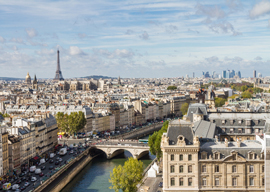
September 07, 2014

Paris, France
Source: Shutterstock
For us, it is not beauty or grandeur that we use to overawe, but size and scale. We reduce Man by our buildings to the scale of insects under our foot. This is clearly expressed by the appalling architect-hero of Ayn Rand’s novel, The Fountainhead, called Howard Roark. For Rand, herself a power-worshipper, overwhelming size equalled mastery, and Roark’s last commission was of a giant skyscraper, larger than all others. The size guaranteed the worth, and actually is the only distinguishing feature that the author is able to provide of her hero’s masterwork.
There is more than one reason why now we fear beauty and scarcely dare protest at ugliness. It is an historical fact that the greatest human art has always been produced in societies that were profoundly unequal, undemocratic, unjust and often, by our standards, cruel. It is more or less incontestable that the artistic production of mediaeval and renaissance Florence, with a population a seventh of that of contemporary Metropolitan Akron, Ohio, or a quarter of that of the London borough of Croydon, was of greater value than that of the whole of the western world, with a population 7000 times greater at least, for the last seventy years (if not very much longer than that). Social democracy has been good for the comfort of millions but disastrous for art and architecture. Replying once in a public forum to an art critic of the British conservative newspaper, the Daily Telegraph, who extolled the position of London as a world art capital, I said that nevertheless its entire output was not worth one picture by Memling, and what’s more was never going to be. London might be an art capital city of the world compared with all the others, but that only went to show how artistically impoverished the world had become. I think it fair to say that everyone in the audience”an educated one”knew exactly what I meant.
Since beauty is often and so obviously the product of unjust societies, not only in Europe but everywhere else, we are afraid of it. Beauty is tainted by injustice; and since nowadays we value justice, fairness and equality above all things, and make them the touchstone of value, beauty makes us uneasy. This does not mean that aesthetes should call for unjust regimes: that would be an error of logic. Because beauty is produced in conditions of injustice, it does not mean that conditions of injustice produce beauty. Modern autocracies are aesthetically at least as disastrous as social democracy, indeed usually more so, but they have all the drawbacks, to put it mildly, of autocracies. Our main artistic task is to preserve remnants.